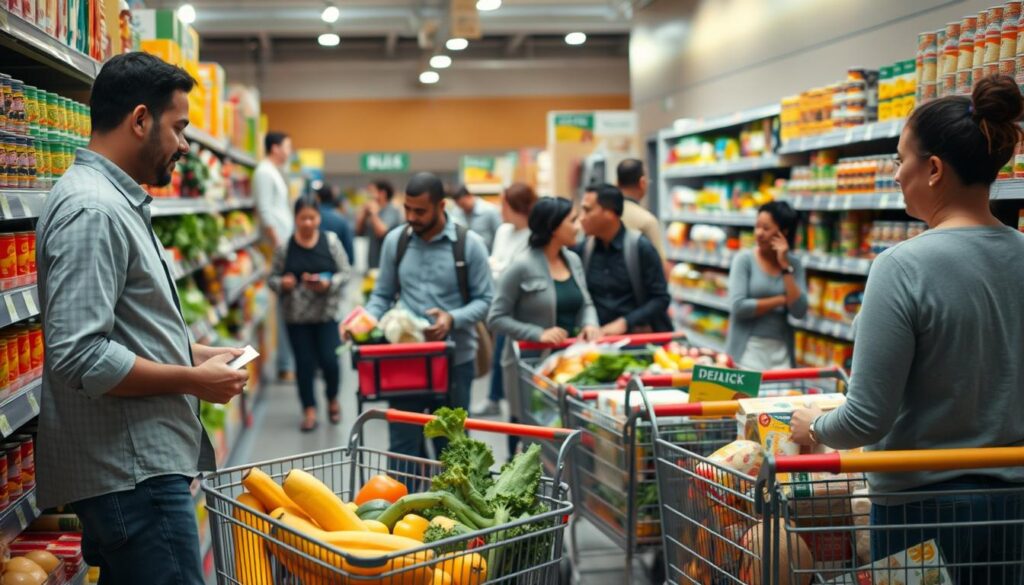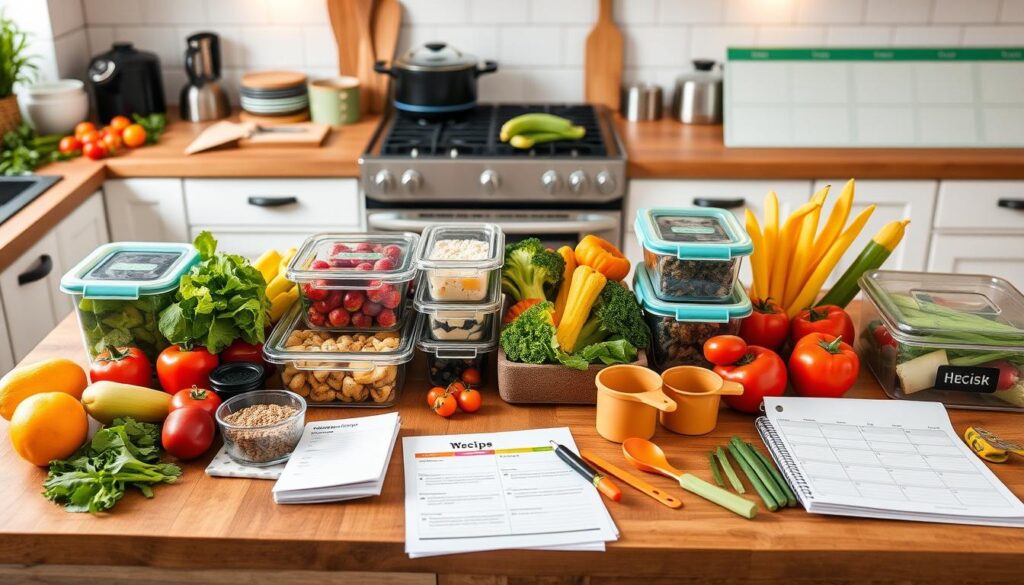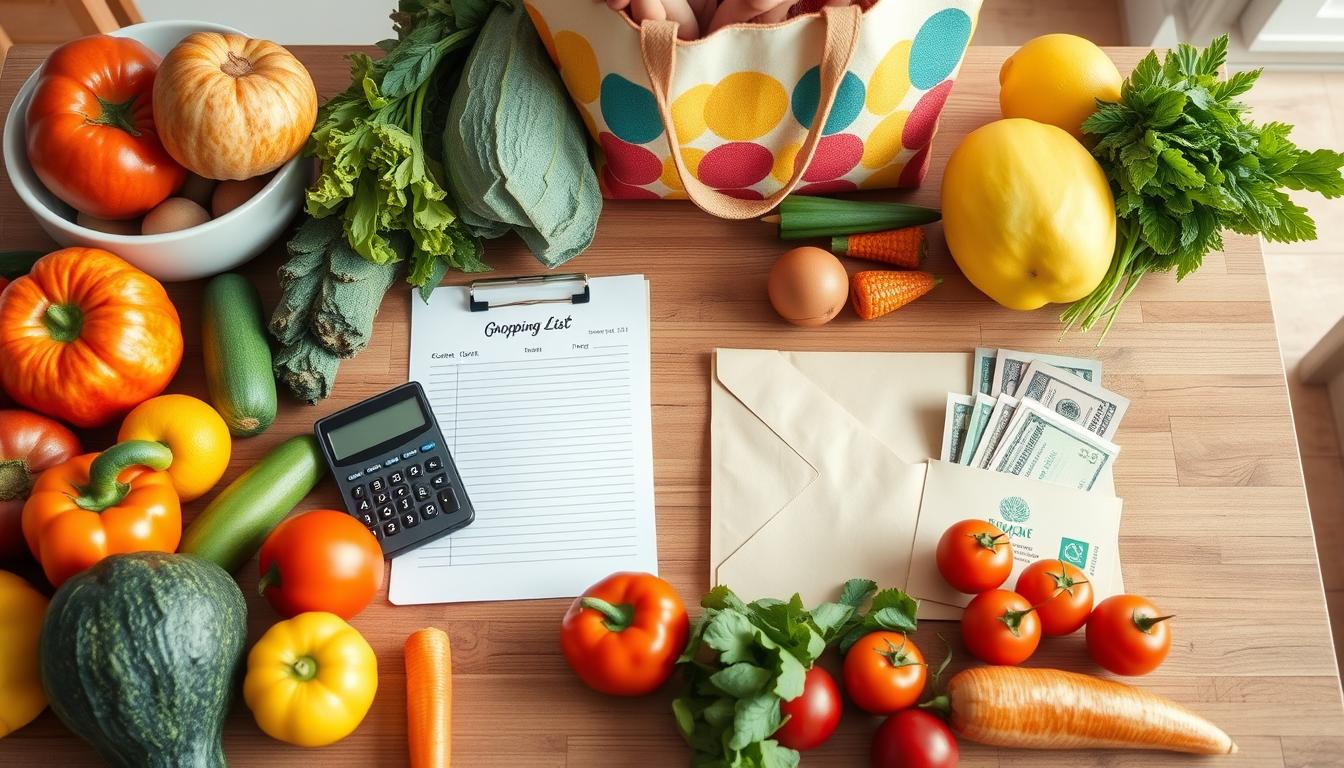Grocery prices have gone up by 22.5% in the last four years. This makes it crucial for families to find ways to stretch their budgets. Luckily, you don’t have to give up on quality or variety. This guide will show you how to cut down on grocery costs without losing out on your favorite meals.
Learn to redefine your dinner plans and get better at shopping. Discover how to use what you already have at home and find the best deals with coupons. This article will give you the tools to take control of your grocery budget. You’ll learn how to save money on your shopping trips and keep your household finances stable in the long run.
Table of Contents
Understanding Modern Grocery Shopping Challenges
In recent years, grocery prices have gone up a lot. Inflation has changed how people shop for food. Prices rose 1.1% last year, after a 3.6% jump the year before. Before that, prices soared by 13.1%. Now, people need to shop smarter to save money.
Impact of Recent Price Increases
The price hikes have made people think differently about shopping. Grocery inflation has led to more careful buying. Shoppers aim to get the most value for their money.
Common Shopping Mistakes to Avoid
One big mistake is buying things on impulse. This can make your grocery bill too high. By comparing prices and using a shopping list, you can avoid extra costs. Also, knowing market trends helps you shop better and save money.
Current Market Trends
Now, people look for value when they shop for groceries. They prefer stores and brands that offer good deals. This has made private label products more popular and discount stores more sought after. Also, more people want to buy sustainable products.

Creating an Effective Meal Planning Strategy
Meal planning is key for saving money on groceries. By planning your meals for the week, you can use ingredients in more ways. This method cuts down on stress and stops the urge for expensive takeout.
Meal planning has many benefits, including:
- Less food waste by using leftovers and avoiding impulse buys
- More efficient cooking, saving time in the kitchen
- Better control over your budget-friendly recipes and grocery costs
To make a good meal prep plan, first check what you have in your pantry and fridge. Use what you already have to plan your weekly meal plans. This way, you make the most of what you have and avoid buying too much.

- Plan for 4-5 dinners a week, leaving room for leftovers or eating out.
- Keep new ingredients to four or fewer per recipe to cut down on waste and cost.
- Buy in bulk for items like rice, beans, and flour to save money.
- Use online grocery flyers and coupons to plan meals around sales and discounts.
With a smart meal planning strategy, you can make grocery shopping easier. You’ll waste less food and save money on your weekly food bills.
Smart Shopping Preparation Techniques
Getting ready is key to saving money on groceries. First, make detailed shopping lists based on your meal plans and what you already have. This helps you buy only what you need, cutting down on impulse buys and food waste.
Making Detailed Shopping Lists
Plan your meals for the week or month carefully. Then, use that plan to make a complete grocery list. Grocery list creation helps you avoid spending too much and stay within your budget.
Checking Pantry Inventory
Pantry organization is crucial to avoid buying things you already have. Do a quick check of your pantry, fridge, and freezer before you go shopping. This way, you can make sure you don’t buy things you don’t need.
Setting Budget Boundaries
Set a clear budget for your grocery shopping each month or week. Divide this amount by how often you plan to shop. This helps you stay on track and make smart choices while shopping.
Using these smart shopping tips, you can make the most of your grocery budget. You’ll buy less on impulse and make sure you have everything you need without spending too much.
What Are The Best Ways To Reduce Spending On Groceries
With grocery prices going up, it’s key to find ways to cut costs. There are many smart tips and strategies to save money on food. Let’s look at some top ways to make your grocery budget go further.
Choosing generic or store-brand products is a big help. They can be up to 29% cheaper than name-brand items, yet still good quality. Also, shopping at discount stores like Aldi can save you a lot on many items.
- Use coupons and apps like Ibotta, Receipt Hog, and Checkout 51 to get cashback and discounts. This can really help with grocery savings.
- Plan your meals and make a detailed shopping list to avoid buying things you don’t need. This can stop you from spending too much.
- Buy produce that’s in season. It’s usually cheaper than out-of-season items. This smart shopping tip can save you a lot of money.
Also, check prices online before you go shopping. This can help you find the best deals. And, try not to shop when you’re hungry. This can help you avoid spending too much. By using these cost-cutting strategies, you can cut down on your grocery spending without sacrificing the quality of your food.
Leveraging Store Sales and Promotions
Savvy grocery shoppers know timing is key. They plan their shopping trips to save money. By knowing when stores have sales, you can buy more for less.
Understanding Sales Cycles
Most grocery stores have sales patterns. They sell certain items at regular times. Look at weekly flyers and digital ads to find sales.
This way, you can buy items you use often when they’re cheapest. It helps you save a lot.
Using Digital Coupons Effectively
Digital coupons from apps like Ibotta and Checkout 51 add extra savings. Explore these apps and clip coupons for items on your list. Use digital coupons with in-store sales for even more savings.
Maximizing Loyalty Programs
Many stores have loyalty programs for frequent shoppers. These programs offer discounts, personalized offers, and points for future buys. By joining these programs, you get special savings and benefits.
Using store sales, promotions, digital coupons, and loyalty programs can cut your grocery costs. You don’t have to give up quality or variety.
Strategic Bulk Buying Approaches
Bulk purchasing can save you a lot on grocery bills. By using warehouse clubs and smart bulk buying, you can cut down on everyday item costs. But, it’s important to plan well to save money without wasting food.
Buying in bulk saves money. Studies show you can save about $2,050 a year by buying common food items at places like Costco. For example, you can save at least $25 a year on items like frozen blueberries, ground turkey, tomatoes, and almond milk.
Buying in bulk also saves time. Warehouse clubs like Costco have many locations, making it easy to get what you need without going to the store often. This is great for people who are always busy or want to spend less time shopping.
- Focus on non-perishable or slow-to-perish items like grains, canned goods, dried beans, pasta, and spices, as these are ideal for bulk buying.
- Consider the storage space available in your home and buy only what you know you’ll use within a reasonable timeframe to avoid food waste.
- Factor bulk purchases into your monthly budget to ensure you don’t overspend and stay within your financial constraints.
By being smart about bulk buying, you can save a lot on groceries. You’ll also cut down on packaging waste and have what you need at home. Whether you shop at a warehouse club or online, this smart shopping can really help your budget.
Smart Brand Choices: Generic vs Name Brands
Looking to save money on groceries? Choosing between generic and name-brand products can help a lot. Generic items are about 40% cheaper than name brands. For example, picking store-brand dinner ingredients can save you around $500 a year.
Quality Comparison Insights
Many chefs and healthcare experts prefer generic products, especially for baking and medicine. A study found 75% of people think store-brand items are just as good as big brands. Plus, one in five store-brand products is made by a top manufacturer, ensuring quality.
Price Differential Analysis
Generic products can save you a lot of money. Things like milk, juice, and spices are often the same price, no matter the brand. But, the biggest savings come on pricier items. A test showed store-brand olive oil and coffee were over 50% cheaper than name brands.
By comparing quality and prices, you can make smart choices that fit your budget. Remember, generic products are a cost-effective choice without losing quality. They help you save money on groceries.
Seasonal Shopping Benefits
Savvy shoppers find big savings in seasonal produce. When fruits and veggies are in peak harvest, they’re cheaper and better quality. Visiting local farmers markets is a smart way to get seasonal produce at the best affordable prices. By planning meals with seasonal ingredients, you can save a lot.
Different crops are at their best at different times, offering fresh and tasty options at local farmers markets. Buying seasonal produce saves money and helps local farmers. It lets you enjoy top-quality ingredients at the best prices.
To make the most of seasonal shopping, watch the calendar and plan meals. Update your grocery list with the seasonal produce that’s in season. This way, you save money without losing flavor or nutrition.
Embracing seasonal produce is a great way to stretch your budget. By shopping at local farmers markets and using seasonal ingredients in your meals, you get tasty, affordable food. Plus, you support your community’s local food producers.
Digital Tools and Apps for Savings
In today’s digital age, many apps and tools can help you save on groceries. From apps that compare prices to cashback programs, they make saving easy. These digital tools help stretch your budget further.
Price Comparison Applications
Apps like Flipp gather sale flyers and digital coupons from local stores. They let you compare prices and find the best deals. Using these apps helps you avoid overspending on shopping trips.
Cashback Programs
Cashback rewards are great for saving money. Apps like Ibotta, Receipt Hog, and Checkout 51 give rebates on grocery items. Just scan your receipts or link your loyalty cards to earn cashback.
Using these grocery apps and price comparison tools can save you a lot. They make you a smarter, more cost-conscious shopper. This way, you can optimize your grocery budget and enjoy more financial flexibility.
Alternative Shopping Venues
Looking for ways to save money on groceries? Check out discount stores like Aldi. They offer great deals on many items, helping you stretch your budget. International markets can also be a good choice for specific items, especially ethnic ingredients and specialty foods.
For fresh, local produce, farmers markets are perfect. You support your community and find organic, in-season items at good prices. This can save you a lot on your grocery bill.
Being open-minded when grocery shopping is key. Try different places to find the best deals. This way, you can save money and find what you like within your budget.
Flexibility is the secret to saving on groceries. Don’t stick to the same places. Explore your local community for hidden savings. With a bit of research, you can find affordable grocery options and manage your family’s food budget better.
Food Storage and Preservation Methods
Proper food storage and preservation can really help you save money. By learning effective techniques, you can keep your food fresh longer. This way, you waste less and spend less on groceries.
Freezer Meal Techniques
Freezer meal preparation is a smart way to stretch your budget. Cooking in bulk and freezing meals saves time and money. It stops you from buying expensive takeout.
Proper Storage Guidelines
Storing food right is key for food preservation. Use airtight containers for pantry items and keep perishables at the right temperature. A vacuum sealer is also great for freezing meals for months.
Learning to preserve and freeze food can control your grocery spending. A well-stocked pantry and freezer mean more homemade meals. This saves time, money, and effort.
Reducing Food Waste Strategies
Meal planning and using leftovers are great ways to cut down on food waste. Before you go shopping, check what you already have at home. This helps you make meals that use up what’s about to go bad. Also, be careful with how much food you make to avoid having too much.
Don’t let leftovers sit unused. Get creative and make new dishes with them. Leftover recipes can make your food last longer and reduce waste.
For scraps that can’t be eaten, think about composting. Composting turns food waste into soil for your garden. This meal planning and leftover strategy, along with composting, can greatly reduce landfill waste from your home.
Using these methods can save you money and help the planet. It’s good for your wallet and the environment.
Budget-Friendly Protein Alternatives
Grocery costs can add up, especially for protein-rich foods. But, there are affordable protein options that save money without losing nutrition. Check out these choices to keep your diet healthy and your wallet happy.
Plant-based proteins like beans, lentils, and tofu are both affordable and full of nutrients. They’re cheaper than animal proteins and can be used in many dishes. Adding these to your meals can boost your protein intake without spending a lot.
For meat, look at cheaper cuts like pork chops, ground turkey, and roasts. These can feed more people, helping stretch your budget. Also, canned fish like tuna and sardines are cheaper than fresh seafood but still rich in protein.
Eggs are another cheap protein-rich food for many dishes. They’re great in scrambles, omelets, and baked goods. Eggs are a smart way to add protein to your meals without spending a lot.
By trying these affordable protein sources, you can enjoy nutritious meals without overspending. With a bit of creativity, you can make tasty, budget-friendly meals that are good for your health.
Being smart about your protein choices can save you money on groceries. Try these affordable options and find what you like best. This way, you can eat well and stay within your budget.
Conclusion
Using these strategies can cut down your grocery costs without losing meal quality. Key points include planning meals well, shopping smart, using sales, and cutting down on waste. These steps can save you a lot of money over time, making it easier to manage your budget.
By using tips for saving on groceries, you can change how you shop and improve your finances. Look for end-of-season sales, buy in bulk, or try new places to shop. There are many ways to save money on what you buy.
Planning and research can make a big difference in saving money on groceries. Follow these tips to spend less and still enjoy tasty, healthy meals. Start saving on groceries and see your finances get better.


